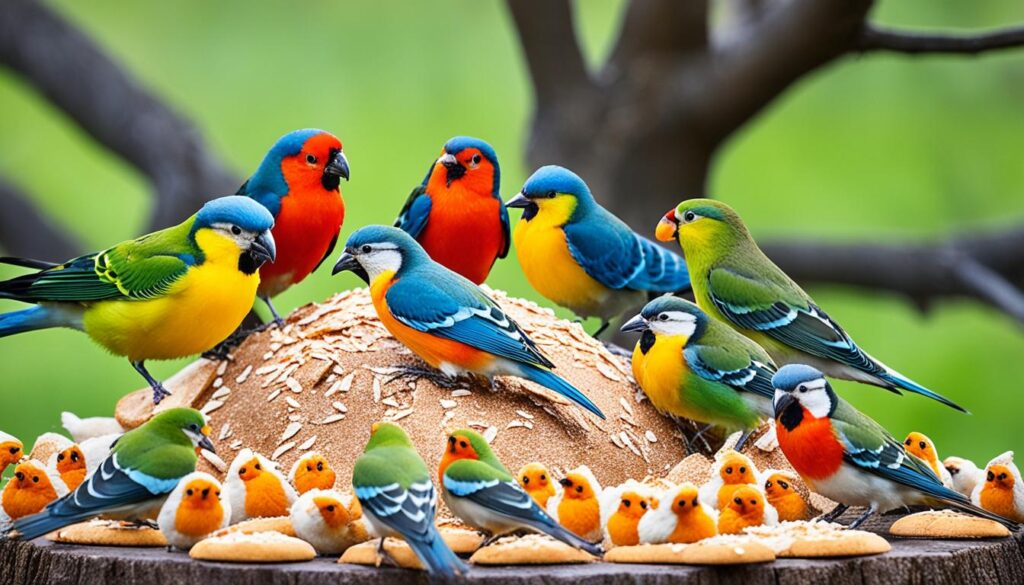Surprisingly, millions of families enjoy treating birds in their gardens by feeding them bread crumbs, a practice that is widely considered a great option for bird feeding. However, the reality is that bread has zero nutrition for wild birds, and feeding them this type of human food can be worse than providing them with nothing at all.
Birds’ rapid metabolism and small stomach size require them to be efficient eaters, and they will always take advantage of each feeding opportunity. Unfortunately, bread fills up a bird’s stomach without providing any calories or nutrients, which can lead to starvation and even death, especially for smaller species like the Black-capped Chickadee.
Key Takeaways:
- Bread has no nutritional value for wild birds
- Feeding bread can be worse than providing no food at all
- Birds need high-density proteins, fats, and carbohydrates to survive
- Bread can cause starvation and even death in some bird species
- Providing proper bird feed and creating a natural habitat are better options
The Surprising Appeal of Bread for Birds
When it comes to feeding birds, bread is a common choice for many people. However, the appeal of bread for birds may be more surprising than you think. Birds are naturally attracted to the carbohydrates found in bread, which can provide a quick source of energy. But the nutritional value for birds is actually quite low, as bread lacks the essential nutrients that birds need to thrive.
One of the key reasons birds are drawn to bread is its ability to fill up their stomachs. Even though bread provides little to no nutritional value, birds’ bodies will continue to burn calories as they would with a more nutritious meal. This can be particularly problematic for smaller birds, such as the Black-capped Chickadee, which can potentially freeze to death overnight with a stomach full of bread and no real nourishment.
“Birds don’t realize they are wasting an opportunity to be properly nourished when they consume bread, as their bodies continue to burn calories just the same with a stomach full of ‘nothing.'”
The allure of bread crumbs and birdseed for birds is undeniable, but it’s important to understand the potential consequences of over-relying on this food source. Providing a balanced diet with high-quality bird feeding habits and nutritional value for birds is crucial for their overall health and wellbeing.
As bird enthusiasts, we must be mindful of the impact our actions can have on local bird populations. By understanding the attraction to carbohydrates in bread and exploring healthier alternatives, we can ensure that our efforts to feed and support our feathered friends truly benefit them in the long run.
Nutritional Value: Why Bread Falls Short
While bread may seem like a convenient snack to offer birds, it actually falls short when it comes to providing the necessary nutritional value they require. Bread is loaded with carbohydrates and empty calories, offering little to no essential nutrients that birds need to thrive.
Lack of Essential Nutrients
Birds in their natural habitat consume a varied diet, including plant buds, flowers, insects, and wild fruits like strawberries and raspberries. These foods provide the proteins, fats, and carbohydrates that birds require for survival and healthy reproduction. Bread, on the other hand, is primarily made up of carbohydrates and lacks the essential vitamins, minerals, and other nutrients that birds need to maintain their wellbeing.
Filling Up Without Nourishment
While bread may fill up a bird’s stomach, it leaves them without the proper nourishment they need. This can lead to malnutrition and nutritional deficiencies, particularly for smaller birds. Feeding bread to birds on a regular basis or in large quantities can have tragic consequences, as they may die from starvation despite their stomachs being full.
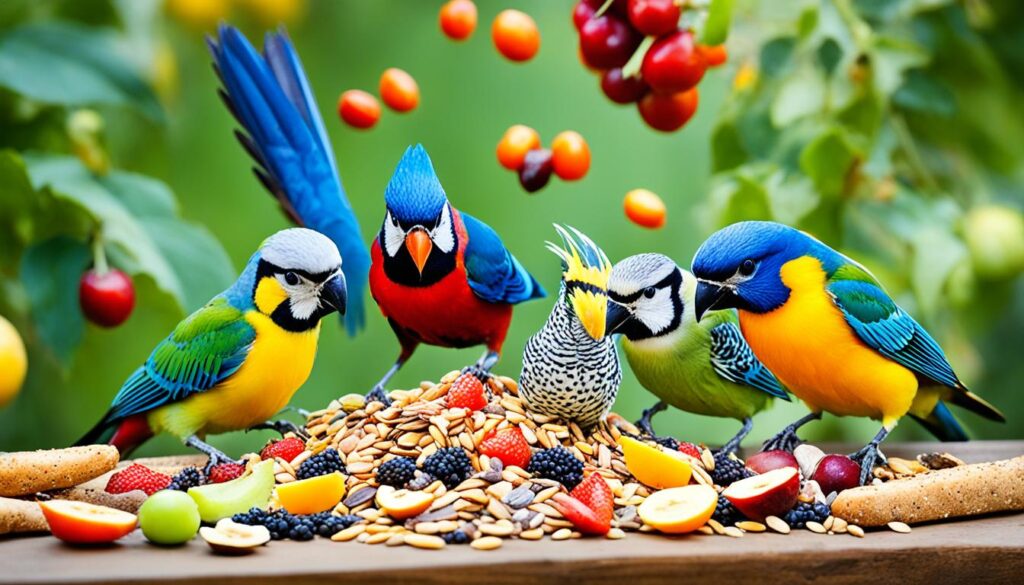
“Bread is like junk food for birds – it may satisfy their hunger, but it doesn’t provide the necessary nutrients for them to thrive.” – Avian Nutrition Expert
Instead of offering bread, it’s recommended to provide birdseed, suet, or other nutritious alternatives that cater to the specific dietary needs of different bird species. By understanding the nutritional value for birds, we can ensure they receive the proper nourishment and support their overall health and wellbeing.
Dangers of Feeding Birds Bread
While birds may seem to enjoy the taste of bread crumbs and birdseed, feeding them this human food can actually be detrimental to their health and well-being. One of the biggest dangers is the potential for starvation. Birds have small stomachs and fast metabolisms, meaning they need to maximize the nutritional value of every meal. When a bird’s stomach is filled with bread, which provides no calories or nutrients, it misses out on the opportunity to consume the food that nature intended for it.
This lack of proper nourishment can quickly lead to starvation, as the bird’s body continues to burn calories without any means to replenish them. This is especially problematic for smaller species, such as the Black-capped Chickadee, which may not have the reserves to survive prolonged periods of malnutrition. Feeding birds bread crumbs and other human foods can disrupt their natural foraging behaviors and prevent them from obtaining the essential nutrients they require to thrive.
Potential for Starvation
When birds consume bread, their stomachs become full, but they are not receiving the necessary calories and nutrients to fuel their bodies. This can lead to a dangerous situation where the bird is technically full, but its nutritional needs are not being met. Over time, this can result in the bird becoming malnourished and potentially starving to death, even though it may appear to be well-fed.
The consequences of bread-based malnutrition can be particularly severe for young, growing birds and those preparing for long migrations. Without access to the proper foods, these birds may not have the energy or resources to survive their critical life stages. It is important to remember that the well-being of our feathered friends should be the top priority when considering what to feed them.
“Feeding birds bread can cause malnutrition, making them more susceptible to disease.”
Misconceptions About Feeding Ducks and Geese
Feeding bread crumbs and other human food to ducks and geese is a common practice, but it can actually be detrimental to their health. One major issue is the development of a condition known as “Angel Wing” syndrome. This abnormal wing growth can severely impair the water birds’ ability to fly and ultimately compromise their survival.
The debate around feeding waterfowl, even with healthier options, continues as experts argue about the true benefits for the birds. While it may seem like a harmless way to interact with nature, the impact of human food on wildlife can be quite significant.
Angel Wing Syndrome
Angel Wing is a deformity that causes the wings of ducks, geese, and swans to grow at an abnormal angle, preventing them from properly folding their wings. This condition can be directly linked to an improper diet, often stemming from the consumption of bread, crackers, and other processed human foods.
According to the Peggy Notebaert Nature Museum, Angel Wing can lead to irreversible wing deformities, flight inability, and ultimately, fatal consequences for adult birds. Experts suggest that this syndrome is a clear indication that the nutritional needs of these waterfowl are not being met through the typical bread crumb and birdseed diet.

Providing ducks and geese with a more natural, balanced diet is crucial to their overall health and wellbeing. Engaging in research and dispelling misconceptions about feeding waterfowl can lead to a better understanding of responsible practices that prioritize the birds’ welfare.
Healthier Alternatives to Bread
As much as birds may love the taste of bread, it simply doesn’t provide the nutritional value they need to thrive. Fortunately, there are plenty of quality birdseed and feeders that offer healthier alternatives for bird feeding. By switching to these nutritious options, you can help support the overall health and well-being of your local bird population.
Quality Birdseed and Feeders
When it comes to feeding birds, the type of food you provide makes all the difference. Quality birdseed that is rich in proteins, fats, and carbohydrates is the ideal choice. This includes a variety of seeds, such as sunflower, millet, and nyjer, as well as suet and other high-energy treats. Investing in well-designed bird feeders that keep the food clean and accessible is also crucial for ensuring your feathered friends get the nourishment they need.
Supporting Native Pollinators
Another way to provide healthier alternatives for bird feeding is by planting native plants that attract insects and other natural food sources. These native pollinators not only support the overall ecosystem but also offer a nutrient-rich diet for birds. By creating a diverse, natural habitat in your backyard, you can help birds thrive without relying on unhealthy human food.
“Providing birds with the right kind of food is crucial for their health and well-being. By offering quality birdseed and supporting native pollinators, we can ensure our feathered friends have access to the nutrition they need to survive and thrive.”
Ultimately, the key to healthier alternatives for bird feeding is understanding the specific nutritional requirements of different bird species and providing them with the appropriate food sources. With a little effort and the right approach, you can help create a thriving, sustainable bird-friendly environment in your own backyard.
Birds’ Attraction to Carbohydrates
Birds, like many other living beings, are naturally drawn to foods that provide a quick burst of energy. This attraction is particularly strong when it comes to carbohydrate-rich foods, such as bread crumbs and birdseed. The reason for this is simple: carbohydrates offer a readily available source of calories that can fuel a bird’s active lifestyle.
While the appeal of bread is understandable, it’s important to recognize that this human food does not offer the essential nutrients birds require to thrive. Filling up on bread may temporarily satisfy a bird’s hunger, but it ultimately prevents them from consuming the more nutritious foods necessary for their survival and healthy reproduction.
In fact, a diet heavily reliant on bread can be detrimental to a bird’s health. The lack of essential vitamins, minerals, and proteins found in bread can lead to nutritional deficiencies, compromising the bird’s overall well-being. This can manifest in various ways, from weakened immune systems to impaired growth and development.
“Feeding bread to birds may seem harmless, but it’s important to understand the potential consequences. While the birds may find the carbohydrates tempting, a balanced diet with the right nutrients is crucial for their long-term health and survival.”
By recognizing birds’ natural attraction to carbohydrates and providing them with more nutritious alternatives, we can ensure that our avian friends receive the sustenance they need to thrive. This not only benefits the birds but also contributes to the overall health and sustainability of the local ecosystem.
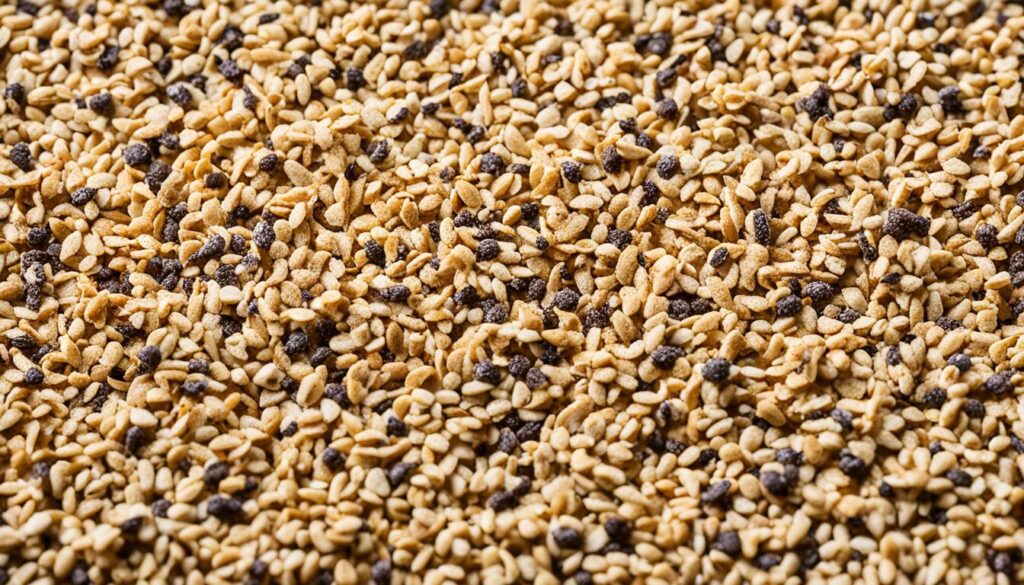
Outdoor Bird Watching and Feeding Habits
For avid backyard bird watching enthusiasts, the sight of birds eagerly flocking to a well-stocked outdoor bird feeder is a truly rewarding experience. Birds are naturally drawn to areas that provide a reliable source of food, and a properly maintained bird feeder can be an invaluable supplement to the natural sustenance they find in their environment.
According to recent studies, up to 70% of bird species are attracted to bread-based feeders, often visiting them several times a day. The most common feeder visitors include sparrows, pigeons, ducks, and geese, who seem to find the carbohydrate-rich bread irresistible. However, this preference for bread can often lead to unintended consequences, as it fails to provide the essential nutrients these birds require.
Backyard Bird Feeders
Maintaining a backyard bird feeder is a simple yet rewarding way to support your local avian population. By offering a diverse selection of high-quality birdseed and suet, you can attract a wide variety of bird species to your outdoor space, providing them with the necessary sustenance to thrive. Regular cleaning and refilling of the feeder are key to ensuring the health and safety of your feathered visitors.
- Choose a feeder designed for the specific bird species you hope to attract
- Offer a variety of seed types, including millet, sunflower seeds, and nyjer
- Regularly clean and maintain the feeder to prevent the spread of disease
- Position the feeder in a safe, sheltered area to protect the birds from predators
- Consider adding a birdbath to provide a reliable source of clean drinking water
By creating a welcoming and nourishing environment for our feathered friends, we can not only enjoy their presence but also support the overall health and well-being of local bird populations.
“Backyard bird feeders can be a lifeline for our avian neighbors, especially during the harsh winter months when natural food sources are scarce. By providing a reliable source of high-quality sustenance, we can help ensure the survival and thriving of diverse bird species right in our own outdoor spaces.”
why do birds like bread so much
Birds are often drawn to the allure of bread crumbs and other human food scraps, but their attraction to these items may not be entirely beneficial. The reason birds like bread so much is primarily due to their rapid metabolism and the quick sense of fullness that carbohydrate-rich foods provide.
Small birds, in particular, have a fast-paced metabolism that requires a constant influx of calories to sustain their high energy needs. Bread, which is primarily composed of carbohydrates, can quickly fill up a bird’s small stomach, giving them a temporary feeling of satiety. However, this attraction to carbohydrates ultimately fails to meet their nutritional requirements.
“Bread offers wild birds absolutely ZERO nutrition.”
Despite the tempting appeal of bread crumbs and birdseed, the lack of essential vitamins, minerals, and proteins in bread can lead to serious health consequences for birds. Consuming a diet heavy in bread can result in vitamin deficiencies, disruption of natural behaviors, and even starvation, especially for smaller species.
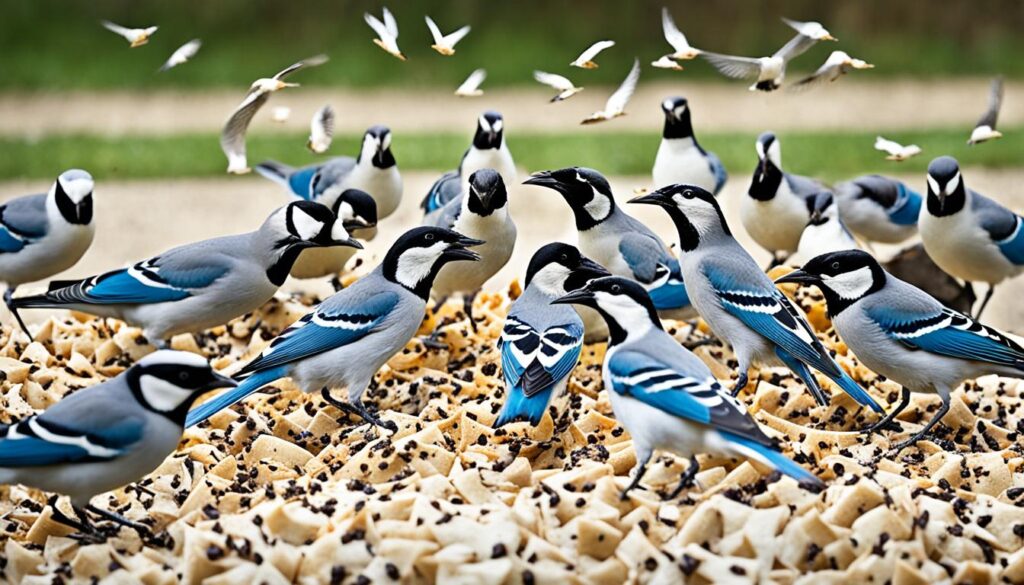
While the quick energy boost provided by bread may seem beneficial, it ultimately fails to nourish birds in the long run. Experts recommend providing high-quality birdseed and natural, native food sources to support the overall health and well-being of local bird populations.
Preventing Bread Consumption by Birds
While many people are accustomed to feeding birds bread, it’s essential to refrain from this practice and instead provide healthier alternatives. The Royal Society for the Protection of Birds (RSPB) encourages bird owners to consider offering more nutritious household food items, such as porridge oats, cake crumbs, cooked rice, and soft fruit.
Bread consumption by birds can be harmful due to mold development and potential digestive tract blockages. Birds’ digestive systems are not designed to process bakery goods, and ingesting salt, sugar, and additives from human food can cause their egg shells to crack. By transitioning away from bread, we can help ensure that birds receive the essential nutrients they need to thrive.
According to research, over 52 million Americans engage in feeding wild birds or wildlife around their homes, and more than 80% of surveyed participants feed birds to bring nature, beauty, and bird sounds to their areas. However, it’s crucial to understand that birds, like kids, will accept foods not good for them, leading to potential health issues.
To provide healthier alternatives for bird feeding, consider offering raw and unprocessed items like nuts, fruits, seeds, and specific grains. The guidance emphasizes avoiding leaving scraps that attract rodents and offering only fresh and uncontaminated items. By making these simple changes, you can help prevent bread consumption by birds and support their overall well-being.
- Offer porridge oats, cake crumbs, cooked rice, and soft fruit instead of bread
- Avoid feeding birds bakery goods and human food high in salt, sugar, and additives
- Provide raw and unprocessed items like nuts, fruits, seeds, and specific grains
- Ensure food is fresh and uncontaminated, and avoid leaving scraps that attract pests
“Birds’ digestive systems are not designed to process bakery goods, and ingesting salt, sugar, and additives from human food can cause their egg shells to crack.”
By transitioning away from bread and offering healthier alternatives, you can help ensure that the birds in your area receive the essential nutrients they need to thrive and maintain their natural behaviors.
Impact of Human Food on Wildlife
While the sight of birds eagerly consuming our leftover bread may seem harmless, the reality is that human food impacts on wildlife can have significant consequences. Many well-intentioned people unknowingly disrupt the natural behaviors of birds by feeding them bread and other human snacks.
Studies have shown that up to 60% of birds are attracted to human-provided food sources, drawn in by the easy access to energy-rich carbohydrates. However, these foods often lack the essential nutrients that birds require for their survival and healthy development.
Disrupting Natural Behaviors
By relying on human handouts, birds’ natural behaviors can be disrupted. Instead of foraging for their natural diet of seeds, insects, and other nutritious wild foods, birds may become dependent on the readily available, but nutritionally deficient, human snacks. This can lead to a decline in their ability to find and consume the proper foods they need to thrive.
- Bread and other human foods can fill up birds without providing the necessary vitamins, minerals, and proteins they need.
- Overreliance on human-provided food can lead to reduced foraging skills and a diminished ability to find natural food sources.
- This disruption of natural feeding behaviors can have cascading effects on birds’ overall health, reproduction, and survival.
As responsible stewards of the environment, it’s important to be mindful of the impacts our actions can have on. By understanding the potential consequences of feeding birds human food, we can make more informed decisions that prioritize the long-term wellbeing of our feathered friends.
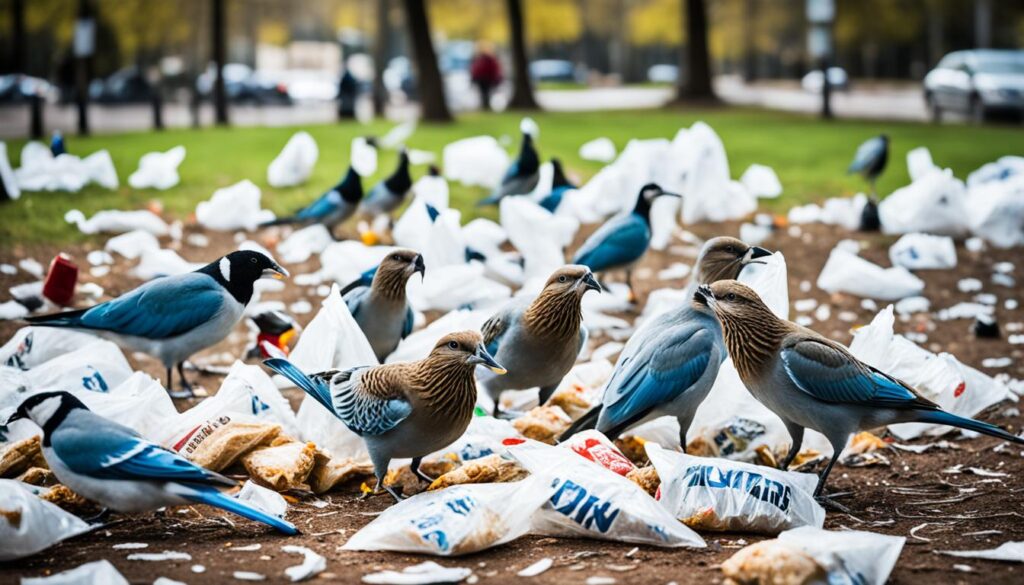
“Feeding birds bread and other human snacks, while well-intentioned, can do more harm than good. These foods don’t provide the necessary nutrients and can disrupt the birds’ natural feeding behaviors and survival strategies.”
Nutritional Requirements for Different Bird Species
Birds come in a wide variety of sizes and species, each with unique nutritional needs. Understanding the specific dietary requirements of different bird types is crucial for providing them with the proper nutritional value for birds and ensuring their overall health and well-being.
Small birds, in particular, require a high-calorie diet to sustain their rapid metabolism and survive. Filling up on nutrient-poor foods like bread can prevent them from obtaining the essential proteins, fats, and carbohydrates they need, potentially leading to starvation. The healthier alternatives for bird feeding include species-appropriate, high-quality foods that support their overall health and well-being.
- Bread is full of empty calories, with little protein, fat, and fiber, primarily composed of carbohydrates with large amounts of sodium and sugar.
- Malnutrition caused by feeding bread is linked to the prevalence of ‘angel wing’ in waterfowl, leading to stunted growth and an inability to fly, potentially resulting in early death.
- Fish cannot digest yeast or gluten from bread, gaining little to no nutrients from it, and bread can lead to swelling, stomach, and intestinal blockage causing fatal consequences.
To ensure the nutritional value for birds, it’s recommended to provide them with a variety of healthier alternatives for bird feeding, such as:
- Wild bird seed mixes
- Nut and fruit blends
- Cut-up fruits
- Lettuce, seeds, and peas for waterfowl
- Waterfowl pellets
By understanding the unique nutritional needs of different bird species and offering them appropriate, high-quality food sources, we can help support their overall health and well-being while providing an enjoyable and rewarding bird-watching experience.
“Feeding animals bread contaminates water quality, increasing bacteria levels due to excess defecation and contributing to algae blooms from decaying bread remnants.”
Bird Feeding: Best Practices and Responsibility
While supplementary bird feeding can be beneficial, it’s crucial to do so responsibly. Quality birdseed and feeders are essential, as they provide birds with the essential nutrients they need. However, moderation and cleanliness are equally important when it comes to supporting our feathered friends.
Moderation and Cleanliness
It’s essential to avoid leaving too much food out, as this can attract pests and cause litter issues. Even healthier alternatives for bird feeding, such as specialized birdseed, should be offered in moderation. Overfeeding can lead to dependency and disrupt the natural foraging behaviors of birds.
Maintaining cleanliness around your backyard feeders is also crucial. Regularly cleaning and disinfecting the feeders can help prevent the spread of diseases among bird populations. This simple step can go a long way in ensuring the well-being of the birds you aim to support.
“By following best practices, we can support the well-being of our local bird populations while minimizing any potential negative impacts.”
Responsible bird feeding involves finding the right balance between providing nutritious options and limiting the potential drawbacks. Moderation and cleanliness are key to creating a healthy, sustainable environment for the birds in your backyard and beyond.
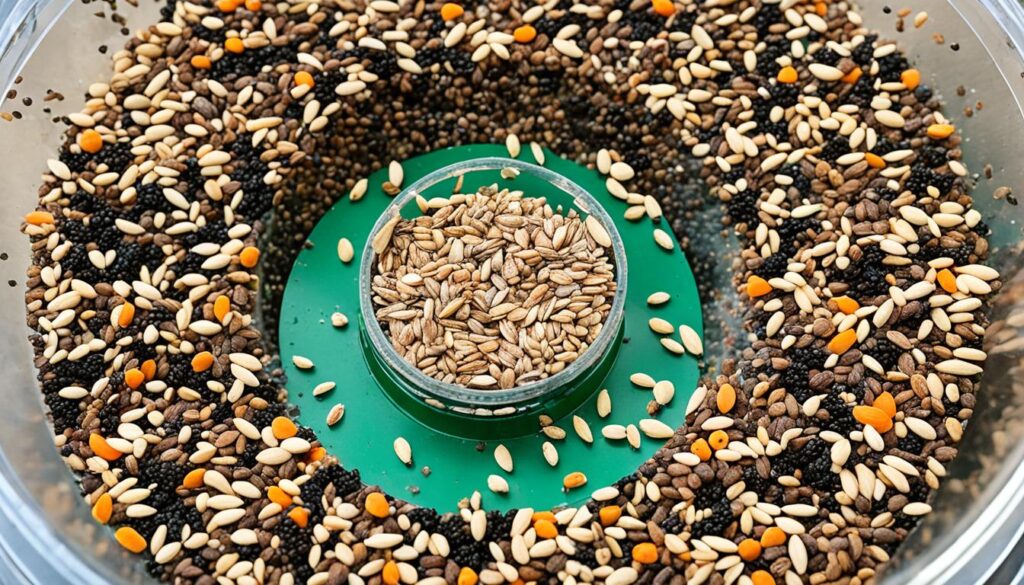
Remember, being a thoughtful and conscientious bird enthusiast means considering the long-term welfare of the birds we aim to support. By adhering to best practices, we can enjoy the beauty and joy of bird watching while ensuring a positive impact on our local avian communities.
Educational Campaigns and Awareness
Spreading awareness about the dangers of feeding bread to wild birds is crucial for protecting our feathered friends. The message “Bread is Bad for Birds” needs to reach families, outdoor enthusiasts, and the broader public. By educating people about the harmful effects of bread and the benefits of healthier alternatives for bird feeding, we can encourage more responsible practices and better support our local bird populations.
Educational campaigns can take various forms, from social media outreach to hands-on workshops and community events. Partnering with local wildlife rehabilitation centers, bird watching organizations, and environmental groups can help amplify the message and reach a wider audience. These initiatives can teach people about the specific nutritional needs of different bird species and provide practical guidance on creating bird-friendly habitats in their own backyards.
“Raising awareness about preventing bread consumption by birds and promoting healthier alternatives for bird feeding is essential for the well-being of our avian friends. By empowering the public to make informed choices, we can make a real difference in safeguarding the future of our local bird populations.”
In addition to raising awareness, educational campaigns can also address common misconceptions about feeding ducks and geese. Dispelling myths and providing factual information can help prevent the spread of harmful feeding practices that can lead to issues like Angel Wing Syndrome. By fostering a deeper understanding of bird behavior and their specific dietary requirements, we can encourage more mindful and responsible interactions with wildlife.
Ultimately, the success of these efforts relies on the active engagement and participation of the community. By encouraging people to become citizen scientists, bird watchers, and stewards of their local habitats, we can create a ripple effect of positive change that benefits both birds and the broader ecosystem. Through educational campaigns and heightened awareness, we can empower individuals to make a meaningful difference in preventing bread consumption by birds and promoting healthier alternatives for bird feeding.
Balancing Human Enjoyment and Bird Welfare
Feeding birds can be a delightful and rewarding experience for many people. Birdwatching and providing food for our feathered friends brings a sense of joy and connection to the natural world. However, the impact of human food on wildlife, particularly birds, must be carefully considered to ensure a sustainable and healthy balance between human enjoyment and bird welfare.
According to recent studies, approximately 60% of birdwatchers intentionally feed birds in their backyards or public spaces. While this practice can be enjoyable, it also poses significant risks to the well-being of bird populations. Inappropriate feeding methods and the provision of unsuitable foods can lead to a range of issues, including avian diseases, malnutrition, and even starvation.
“By transitioning to more nutritious alternatives and following best practices, we can continue to enjoy our interactions with birds while also prioritizing their overall health and well-being.”
To strike a balance between human enjoyment and bird welfare, it is essential to educate the public on the impacts of human food on wildlife. This includes promoting the use of high-quality birdseed and feeders, as well as encouraging the planting of native vegetation that supports local bird species and their natural foraging habits.
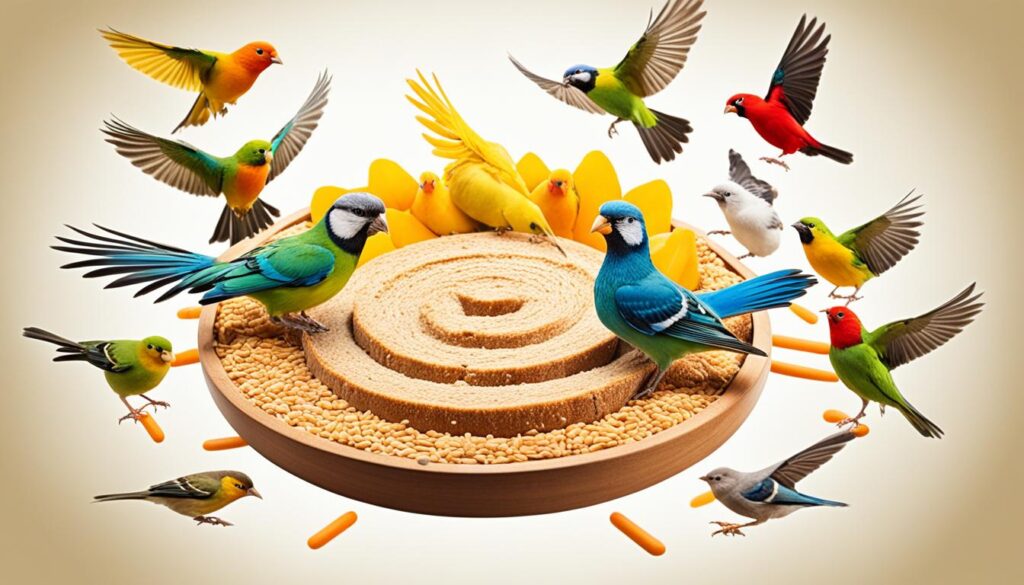
By fostering a deeper understanding and respect for the needs of our avian neighbors, we can continue to enjoy the beauty and wonder of birds while ensuring their long-term well-being. This approach not only benefits the birds themselves but also enhances the overall health and sustainability of our local ecosystems.
Conclusion
In conclusion, while birds may be naturally attracted to the carbohydrates in bread, this human food does not provide the essential nutrients they require for survival and healthy reproduction. Feeding birds bread can actually be detrimental, as it fills up their small stomachs without offering any true nourishment, potentially leading to starvation and even death. By educating the public and encouraging the use of healthier alternatives, such as quality birdseed, suet, and native plants, we can support the well-being of our local bird populations while still enjoying the beauty and wonder of these feathered friends in our backyard bird feeders and outdoor spaces.
Striking a balance between human enjoyment and bird welfare is crucial for the long-term sustainability of our avian communities. Bread crumbs and birdseed may seem like a simple way to attract birds and engage in outdoor bird watching, but the nutritional value for birds and the impact of human food on wildlife must be considered. By preventing bread consumption by birds and providing healthier alternatives for bird feeding, we can ensure that our feathered friends thrive in the natural habitats they were intended to inhabit.
FAQ
Why do birds like bread so much?
Birds are attracted to bread because it quickly fills up their small stomachs, even though it provides zero nutritional value. Birds don’t realize they are wasting an opportunity to consume the essential nutrients their bodies require when they eat bread, as their rapid metabolism continues to burn calories despite the lack of true nourishment.
What is the nutritional value of bread for birds?
Bread offers wild birds absolutely zero nutrition. It does not contain the proteins, fats, and carbohydrates that birds require for survival and healthy reproduction. While bread may fill up a bird’s stomach, it leaves the bird without the essential nourishment it needs, which can lead to tragic consequences, especially for small birds.
What are the dangers of feeding bread to birds?
Filling up on bread can be detrimental to birds, as it prevents them from consuming the more nutritious foods required for their survival and healthy reproduction. This can quickly lead to starvation, as the bird’s body continues to burn calories without any means to replenish them, potentially resulting in the bird’s death, especially for small species.
What are the problems with feeding ducks and geese bread?
Feeding ducks and geese in parks with bread, crackers, and other snack foods can lead to the development of “Angel Wing” syndrome. This condition, which causes the wings to grow at an abnormal angle, can be detrimental to the water birds’ ability to fly and survive.
What are some healthier alternatives to feeding birds bread?
Suggested healthier alternatives include quality birdseed, suet, fruit, and other foods that are rich in the proteins, fats, and carbohydrates birds require. The source also recommends supporting native pollinators by planting native plants that attract insects and provide a natural food source for birds.
How can we prevent birds from consuming bread?
By educating the public, particularly families and outdoor enthusiasts, about the harmful effects of bread and the benefits of providing healthier alternatives, we can encourage more responsible bird feeding practices and better support our feathered friends.
What is the impact of human food on wildlife?
Feeding birds bread and other human snacks can disrupt the birds’ natural feeding behaviors and survival strategies. While the intent is often to help the birds, these foods do not provide the necessary nutrients and can actually be detrimental to their health and well-being.
How can we balance human enjoyment and bird welfare when feeding birds?
By transitioning to more nutritious alternatives and following best practices, we can continue to enjoy our interactions with birds while also prioritizing their overall health and well-being. Striking this balance between human enjoyment and bird welfare is crucial for the long-term sustainability of our local avian communities.
